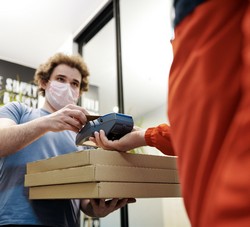In the wake of COVID-19, the nation’s restaurant industry took a severe hit. In an effort to bring awareness to small restaurants and aid them in their struggles, a movement began encouraging community members to support local small businesses.
With indoor dining no longer an option, restaurants relied heavily upon third-party delivery services such as DoorDash, Grubhub, and Uber Eats to make up the in-house business they were unable to generate. App-based delivery services experienced tremendous growth.
According to financial reports for the fourth quarter and full year of 2020, Grubhub alone reported making $504 million – a 48 percent increase from the $341 million the company brought in last year during the same period. Still a relatively new development, the relationship between small restaurants and food delivery services is misunderstood by many. Although responsible for increased sales, are these third-party delivery services taking more than just their fair share of the profits?
“More or less,” replied Mateo Rafael, owner of Nelly’s Pizza in West Long Branch. “It does depend on the service. For some third-party services, they sometimes take about 30 percent when it’s their company drivers delivering food, so using our own drivers has more benefits. As for decreased profits, it hasn’t affected us on a major scale because we use our own drivers.”
In order to lessen the profit cut of going through app-based delivery services, some small restaurants have implemented in-house delivery. Others, however, are not so open to the consideration.
“In my view, third-party is more cost effective,” explained Joe Maruca, general manager of Maruca’s Tomato Pies in Seaside Heights. “Also, the non-monetary variables (finding a driver and ensuring they show up for work) outweigh the cost of third-party.”
Although food delivery services can demand a large percentage of total revenue, it seems that apps like DoorDash, Grubhub, and Uber Eats have contributed to an overall increase in sales for many small restaurants. According to Robert Lipyanek, general manager of Jersey Mike’s in Toms River, third-party orders only accounted for about 7 percent of total sales prior to COVID-19. “Third-party orders were approximately 30 percent of our sales in the wake of COVID,” he said. “Currently, it fluctuates between 18 and 22 percent. It’s hard to say if we would have made it through the pandemic without third-party delivery services as this was a time when many people did not want to leave their homes.”
For Mateo Rafael, however, what would have been the fate of his restaurant without the use of third-party delivery services is more than clear. “It would have just barely survived without the use of those other services,” he explained. “What was really useful was the ability for orders to come in on multiple fronts. So, we didn’t have to just rely on the phoned-in orders (which take a bit more time), but could also take the ones coming in from the apps (which are usually already paid for and are a little faster).”
Businesses with brand recognition and a loyal customer base may have had less to worry about in sustaining in the wake of COVID. “We would’ve survived because of 70 years of goodwill, however, other smaller, less well-known companies would not survive without the use of third-party,” said Joe Maruca. He did not necessarily support the notion that these app-based services are requesting an unreasonable cut of the profit, but instead implied that businesses should make the necessary adjustments to their operation in order to make up for these costs. “Third party apps are taking a reasonable fee,” he added. “Third party services are not cutting into profits, the problem is that business owners haven’t changed their labor model. That is, less labor.” Perhaps with the use of third-party services, small businesses may employ fewer people to make up for the profit cut.
Another benefit to utilizing these delivery services is the fact that they have helped to accommodate customers with their safety concerns over the course of the pandemic. As Mateo Rafael described, “Using these services has made in-store pickup and the ability to have contactless delivery easier. Especially since dining-in is no longer a major part of business.”
Consumers play into this exchange by paying delivery and convenience fees. “I feel that delivery prices and service fees are extremely overpriced,” expressed Mackenzie Kleniewski, Monmouth University student and frequent user of food delivery services. “For instance, a playa bowl is normally $10 in-store but is more than double that price to order it through delivery apps.”
Additionally, these delivery services have made the restaurants responsible for covering the entirety of sometimes hefty commission fees rather than customers. Some small restaurants respond to these fees by driving up the prices of items on their app menus and charging more for deliveries. For example, an establishment is making a $2 profit off of a $12 pizza. If a third-party delivery app is charging $2 for their service, the restaurant is no longer making the profit they once did and therefore must adjust their prices and charge customers accordingly.
So, knowing that some restaurants are forced to cope with these fees from app-based services, would customers be willing to pay the extra few dollars for food that they enjoy? “Yes,” replied Alexis Romano, student at Monmouth University. “To support a small restaurant and make up for their profit cuts? Absolutely.”
It is evident that many small restaurants have suffered at the hands of COVID-19 and have turned to delivery services as a way to remain afloat. The impacts of delivery platforms such as DoorDash, Grubhub, and Uber Eats seem to have varying impacts on different food establishments. Proving to be beneficial to the wellbeing of many businesses, these services also raise concerns about unfair demands of profits. The hope, in the midst of a difficult time, is that the small restaurant industry and third-party delivery services will be able to reach a compromise that is ideal for all parties involved.
IMAGE TAKEN from Pexels.com



